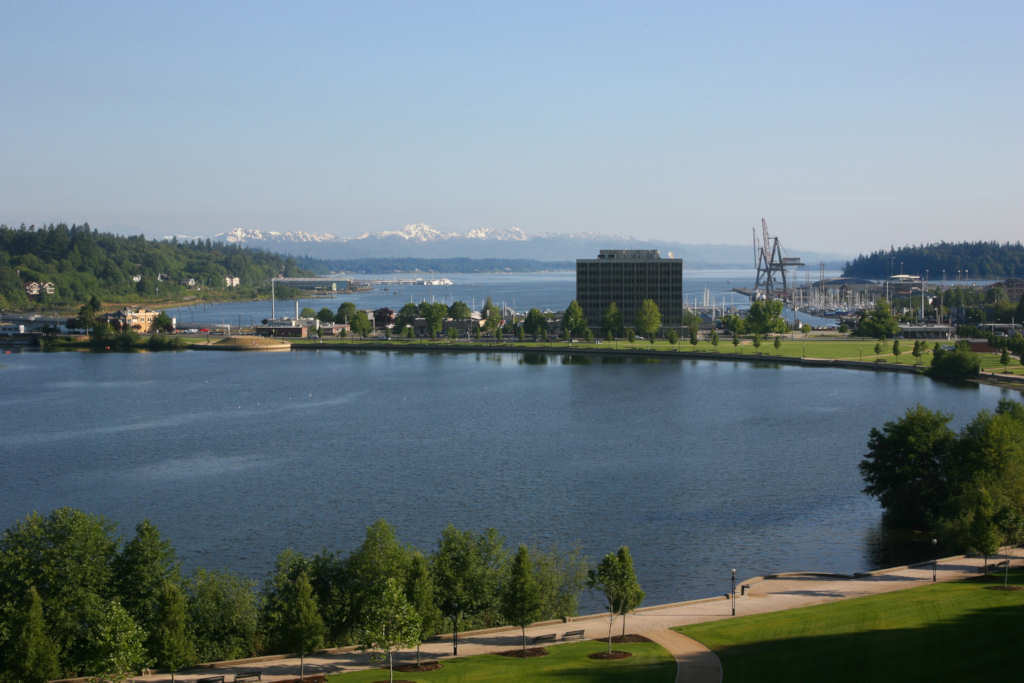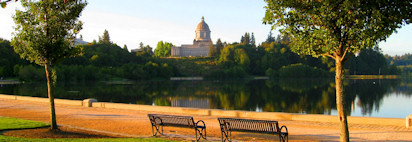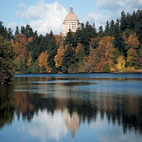Review of Supplemental Modeling Scenarios
David H. Milne PhD - Faculty, TESC (ret.) - July, 2018EXECUTIVE SUMMARY
The Washington Department of Ecology’s Report, “Supplementary Modeling Scenarios” purports to demonstrate
that Capitol Lake’s effect on Puget Sound lowers the dissolved oxygen content of Sound waters and is responsible
for violations of water quality standards there. The Report presents outputs of a complex computer simulation, the
“Budd Inlet Model,” that are said to support the authors’ claims. That is not the case. In fact, errors and shortcomings
aside, data in the Report, not acknowledged by its authors, support the view that Capitol Lake’s effects on
Puget Sound are actually beneficial.
The following problems with the Report are noted. (There are others, too many for a single page summary.)
- 1) Water Quality standards violations in Capitol Lake itself were vastly (and incorrectly) overestimated;
- 2) The calculations of Total Organic Carbon (from plant growth) entering the Sound from the Lake or Estuary scenarios overstate the amount of TOC in the Lake case and understate it in the Estuary case;
- 3) An inappropriate technique was used to calculate East Bay water residence times;
- 4) The authors mistakenly assume that Capitol Lake’s ecology is phosphorus limited and base many pages of irrelevant discussion and calculation on that assumption;
- 5) The Budd Inlet model produces many demonstrably wrong answers where compared with observed data; yet the authors consider every dissolved oxygen calculation accurate to within 0.01 mg/L;
- 6) Answers derived from the authors’ method of finding water quality standards “violations” (based on calculated unknown/unknowable conditions in hypothesized pre-modern waters) are not subject to independent confirmation or refutation (not testable) by scientists elsewhere;
- 7) The authors’ hypothesis of how organic carbon created by plants in the Lake enter and affect Budd Inlet is not ecologically realistic and, contrary to their claim, is not testable by the Budd Inlet model;
- 8) A Figure showing water quality violations in the hypothesized pre-modern (pre-dam) estuary is formatted in a way that makes it impossible to judge the extent of the violations; proper formatting shows that violations are as widespread in that “natural” water (and comparable in size) as they are today with Capitol Lake present;
- 9) A “benthic algae photosynthesis” subroutine failed to show high bottom water oxygen on a day when observations demonstrated this at the critical East Bay cell used as the focus of all simulations – a malfunction that calls into question all of Ecology’s assertions about dissolved oxygen levels in shallow water;
- 10) The authors avoided simulating the effect on the Lake/Inlet interaction that would result from a program of harvesting Lake plants, an option that would almost certainly improve Inlet water quality;
- 11) Low dissolved oxygen levels calculated for the “critical cell” in East Bay are mistakenly attributed to Capitol Lake. They are, instead, almost certainly caused by the immense nitrogen load from the External source;
- 12) Figures included from other sources, said to bolster the authors’ claim, actually show the opposite; beneficial removal by Capitol Lake of nutrient nitrogen from Deschutes River water.
No public policy decisions should be based on the contents of the Supplemental Modeling Report.
Also - see the CLIPA Community Waterfront Management Plan - A Balanced Community & Environmental Management Program, with Hybrid / Split Lake with Restored Estuary and Waterfront options.
Dr. Milne has done several analytical yet very reader-friendly reports about the Deschutes Watershed and Capitol Lake. Dr. Milne background information - Other reports in our files
OUTLINE OF THIS REVIEW
Due to the size, detail, and complexity of this review, we provide
traditional web pages for only the executive summary above and the outline below.
Included in the outline below are links to the PDF file for each chapter or
section. There is also a single PDF containing the entire critical review.
ENTIRE REPORT
The entire report in a single pdf file ( 140 pages, file size about 50 mb)
EXECUTIVE SUMMARY
The Executive Summary is
shown above.
OUTLINE
This outline is also available in PDF format
Additional Information
Tables, Figures, References, Appendix A, & Acknowledgements
1. BACKGROUND: ESTUARIES AND DISSOLVED OXYGEN.
This introductory chapter describes the non-tidal water movements in estuaries and how they relate to the forces that deplete and replenish critical dissolved oxygen in estuary ecosystems.
- 1-1. Introduction.
- 1-2. The Estuarine Circulation; Giant Unseen Flows.
- 1-3. Oxygen Depletion in Estuaries.
- 1-3a. The Oxygen Story in Puget Sound.
- 1-3b. Oxygen Depletion; Seasonal Factors.
- 1-3c. Oxygen Depletion; The Estuarine Null Zone.
- 1-4. Reading the Oxygen Record.
- 1-4a. DO Saturation: Key to Understanding Water Quality.
- 1-4b. Bottom Water Rising in Olympia Harbor.
- 1-5. What’s Driving Low September Dissolved Oxygen Levels in Budd Inlet?
- 1-6. What the Budd Inlet Water Quality Controversy is All About.
2. GOOD SIMULATION, MISTAKEN INTERPRETATIONS.
This introduction describes Ecology’s Budd Inlet computer Model, my early involvement with the lake ⁄ estuary controversy, Ecology’s bias against Capitol Lake, and an overview of the chapters that follow.
- 2-1. About This Review.
- 2-2. Introduction.
- 2-3. The Budd Inlet Computer Model.
- 2-4. Data Sources.
- 2-5. Encounters with the Department of Ecology.
- 2-6. The Review That Follows.
- 2-7. Good Science …
3. THE COMPUTER GETS MANY WRONG ANSWERS.
At least half of the calculations by the model don’t agree with data obtained by the BISS field research. At its worst, the day with the highest DO level of the whole season was the day for which the model predicted the lowest DO level of the whole season - at three sites. One was Ecology’s single most important site; the "critical cell" in East Bay.
- 3-1. Overview.
- 3-2. Counting Right Answers.
- 3-2a. Worst Case Scenario.
- 3-2b. All Model Calculations for the Critical Cell; Flawed?
- 3-3. The Computer’s Margin of Error.
- 3-4. The Biggest Source of Error and Confusion of All.
- 3-5. Minimizing Errors; Possibilities and Ecology’s Responses.
- 3-6. No More “Natural Estuary” Calculations?
4. THE BUDD INLET ESTUARY; “NATURAL” AND MODERN.
"Natural" Budd Inlet before modern times was loaded with DO standards violations. The model shows that modern Budd Inlet with the dam is only marginally worse. Modern Budd Inlet without the dam, however - with all modern human activities – is "shown" to be stupendously better than it was in pre-modern "natural" days – an unlikely proposition. Ecology’s presentation obscures this absurd contradiction and the high violation levels discovered in the "natural" estuary.
- 4-1. Overview of Chapter 4.
- 4-2. The Missing Natural Budd Inlet Grid Map.
- 4-3. Reminder. Interpreting Grid Maps.
- 4-4. Ecology’s “Non-Grid” Natural Estuary Map.
- 4-5. Ecology’s Natural Estuary Converted to Standard Grid-Map Format.
- 4-6. The Modern Budd Inlet Estuary.
- 4-6a. The Sizes of the Nutrient Nitrogen Sources Affecting Budd Inlet
- 4-6b. Budd Inlet Without “The Capitol Lake Dam.” Getting Organized.
- 4-6c. Table 4-1. Summary and Overview of the SM Report’s Scenario Simulations.
- 4-6d. Figure 4-7; Grid Maps of the Dam/No Dam Simulations.
- 4-7. “With Dam” Scenarios Compared; Ecology’s vs. This Review’s Versions.
- 4-8. Summary of With/Without Dam Scenario Outcomes.
- 4-9. Budd Inlet is Better Off With the Dam than Without it.
- 4-10. Optional. Figuring Out the Data Used by Ecology in the Scenarios.
- 4-11. Optional. Transforming the Natural Estuary Grid Map.
- 4-12. Optional (continued). Details and Reliability of the Selection Process.
- 4-13. Optional. The Derivation of “Budd Inlet With No Dam” (Figure 4-7c).
5. ECOLOGY’S BUDD INLET SIMULATIONS: FLAWED SCIENCE.
Ecology has avoided simulations that would show beneficial effects of Capitol Lake, downplayed simulations that show possible improvements without removing the dam, and made calculation errors and statements about hydrodynamics not supported by model outputs, all slanted toward forcing the conclusion that removal of the dam is the only way to improve Budd Inlet’s water quality. This Chapter questions those claims.
- 5-1. Avoidance of Simulations Likely to Exonerate Capitol Lake.
- 5-1a. The Missing Simulation of Plant Harvesting … Background and Evasion.
- 5-1b. The Missing Simulation of Moxlie Creek’s Effect on East Bay.
- 5-2. Downplaying Solutions Other Than Eliminating Capitol Lake.
- 5-3. Trivial Simulations, Meaningless Graphs.
- 5-4. “The Dam” (Not Capitol Lake) is the Problem … or is it?
- 5-5. “Increased Residence Time” – So What? – and a Botched Calculation.
- 5-6. Summary.
6. ECOLOGY’S CENTRAL CLAIM: “THE DAM DEPLETES OXYGEN.” WRONG.
The load of nitrogen entering Budd Inlet from beyond Boston Harbor is 16 times larger than the load entering from Capitol Lake. Yet Ecology insists that Capitol Lake causes eight times as much dissolved oxygen depletion in Budd Inlet’s East Bay as does the external source. They’ve got it backward; this Chapter shows why.
- 6-1. Overview. Why the Claim is Mistaken.
- 6-2. The Availability of Nitrate Nutrients at the East Bay Location.
- 6-3. The Arrival of Nitrogen Nutrients at Priest Point.
- 6-4. The Movement of Nitrogen Nutrients Into and Out of West Bay.
- 6-5. Dissolved Oxygen Depletion in East Bay Caused by “The Dam” – Zero?
- 6-6. Summary. Likely Causes of Low DO Conditions in East Bay.
- 6-7. Conclusions and a Recommendation.
7. ORGANIC CARBON CLAIMS: MISLEADING, MISTAKEN, NOT CREDIBLE.
Calculations claimed to show that Capitol Lake releases more oxygen-depleting organic carbon to Budd Inlet during the growing season than would be released if the dam were removed actually show the opposite; an estuary in that basin would release more organic carbon during the growing season.
- 7-1. Overview.
- 7-2. Background.
- 7-3. The Production of Organic Carbon by Lake and Estuary.
- 7-4. Optional. Estimating TOC from DIN Uptake, using Figures 7-3a and 7-3b.
- 7-5. Results. Estimating TOC from DIN Uptake.
- 7-6. Errors in Ecology’s Calculations and Interpretations.
- 7-7. Waterborne TOC in Real Life.
- 7-8. Real Life Estuaries and Lakes.
- 7-9. Summary of Both Cases.
- 7-10. Why are the Modelers Fixated on Phytoplankton?
- 7-11. How Would These Errors Affect Our View of Dissolved Oxygen in Budd Inlet?
8. THE LATE-SEASON DEPARTURE OF ORGANIC CARBON FROM CAPITOL LAKE.
This Chapter presents real-world observations and ecological explanations of why most organic carbon formed by plants in Capitol Lake can’t deplete dissolved oxygen in Budd Inlet during the growing season.
- 8-1. Ecology’s “Organic Carbon” Hypothesis and the Real World Alternative.
- 8-2. Seasonal Change in Capitol Lake.
- 8-3. Background for Understanding the Late Fall Decline in Dissolved Oxygen in Budd Inlet.
- 8-4. Incoming and Outgoing Water; The Fall Seasonal Effect on Dissolved Oxygen.
- 8-5. Summary. The Search for a Late-Season Lake Effect.
- 8-6. Optional Technical End Note: Ratio of Biomass Between Macrophyte (Large) Plants and Phytoplankton.
9. CAPITOL LAKE: ERRORS AND FALSE CLAIMS.
Ecology’s most grotesque calculation error has created a widespread public perception that Capitol Lake itself is "deficient in oxygen." The Lake actually has higher DO levels than any other lake (or estuary) in the county, year round. Ecology’s calculation error and the real-world facts are described in this Chapter.
- 9-1. There is No Real-Life “Oxygen Depletion” in Capitol Lake.
- 9-2. Ecology’s “Dissolved Oxygen Deficiencies” in Capitol Lake Were Calculated Incorrectly.
- 9-2a. Background for the Correct Calculation.
- 9-2b. Optional: Checking The Dissolved Oxygen Calculation.
- 9-2c. Optional: The Corrected Dissolved Oxygen Calculations.
- 9-3. The Lake’s Calculated Water Quality Violations are Tiny or Nonexistent.
- 9-4. The Phosphorus Wild Goose Chase.
- 9-5. The Eutrophic “Hopeless Phosphorus Red Herring” and the 303-d Listing.
- 9-6. Nutrient Nitrogen – Seldom Mentioned, Never Simulated.
- 9-7. Optional. The DO TABLES Calculations.
- 9-8. Not Optional. The Bottom Line. Capitol Lake is NOT “Oxygen Depleted.” ECOLOGY STOP SAYING THAT IT IS!
10. LOW DISSOLVED OXYGEN IN NATURAL ESTUARIES.
Widespread violations of modern dissolved oxygen standards are calculated by the model for pre-modern Budd Inlet before the dam was built. This unwelcome feature of the "natural" inlet complicates efforts to show that "the dam" is responsible for modern low oxygen episodes there. Ecology’s response; to "update" the model to eliminate low "natural" DO’s. This Chapter presents evidence (from Eld Inlet) that natural DO’s are to be expected.
- 10-1. The Drive to Sanitize Natural Estuaries.
- 10-2. Eld Inlet – A Modern “Natural” Estuary?
- 10-3. Low Oxygen Levels in Modern Eld Inlet.
- 10-4. Eld Inlet with “Natural” Low DO’s; a Second Line of Evidence.
- 10-5. Optional: How the Eld Inlet Profile was Constructed from the Probe Data.
- 10-6. Where Will They Go From Here?
Review of Supplemental Modeling Scenario Report
by: Dr. David H. Milne PhD - July 2018Review of Supplemental Modeling Scenario Report - The Washington Department of Ecology Report, Supplementary Modeling Scenarios, purports to demonstrate that Capitol Lake has a negative effect on Puget Sound water quality. That is not the case. In fact, data in that Report support the view that Capitol Lake effects on Puget Sound are actually beneficial.


